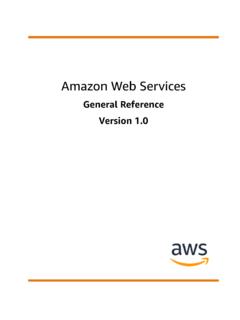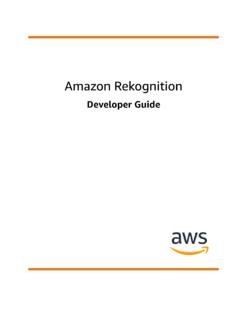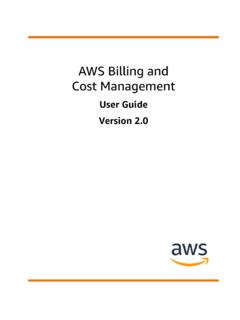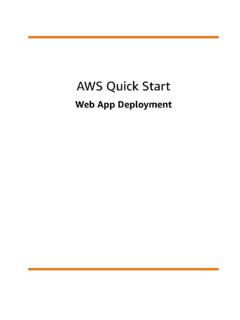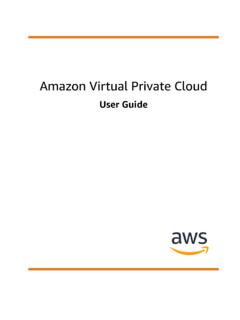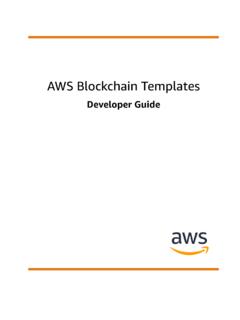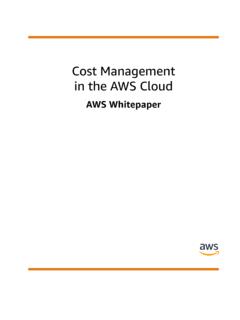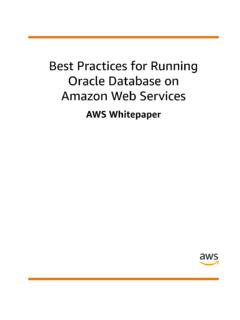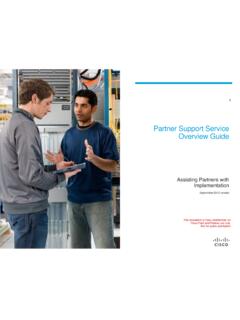Transcription of Building a Scalable and Secure Multi-VPC AWS Network ...
1 Building a Scalable andSecure Multi-VPC AWSN etwork InfrastructureAWS WhitepaperBuilding a Scalable and Secure Multi-VPCAWS Network Infrastructure AWS WhitepaperBuilding a Scalable and Secure Multi-VPC AWS Network Infrastructure:AWS WhitepaperCopyright Amazon Web Services, Inc. and/or its affiliates. All rights 's trademarks and trade dress may not be used in connection with any product or service that is notAmazon's, in any manner that is likely to cause confusion among customers, or in any manner that disparages ordiscredits Amazon. All other trademarks not owned by Amazon are the property of their respective owners, who mayor may not be affiliated with, connected to, or sponsored by a Scalable and Secure Multi-VPCAWS Network Infrastructure AWS WhitepaperTable of ContentsAbstract.
2 1 Abstract .. 1 Introduction .. 2 VPC to VPC connectivity .. 4 VPC 4 Transit VPC Solution .. 5 Transit Gateway .. 6 Transit Gateway vs Transit VPC .. 6 Transit Gateway vs VPC peering .. 7 AWS PrivateLink .. 7 Amazon VPC Sharing .. 8 Hybrid Connectivity .. 10 VPN .. 10 Direct Connect .. 11 Centralized egress to internet .. 14 Centralized Network security for VPC-to-VPC and on-premises to VPC traffic .. 18 DNS .. 21 Hybrid 21 Centralized access to VPC private endpoints .. 24 Interface VPC endpoints .. 28 Document History .. 29 Notices .. 30iiiBuilding a Scalable and Secure Multi-VPCAWS Network Infrastructure AWS WhitepaperAbstractBuilding a Scalable and Secure Multi-VPC AWS Network InfrastructurePublication date: June 10, 2020 (Document History (p.))
3 29))AbstractAWS customers often rely on hundreds of accounts and VPCs to segment their workloads andexpand their footprint. This level of scale often creates challenges around resource sharing, inter-VPCconnectivity, and on-premises to VPC whitepaper describes best practices for creating Scalable and Secure Network architectures in a largenetwork using AWS services like Amazon VPC, AWS Transit Gateway, AWS PrivateLink, and AWS DirectConnect Gateway. It demonstrates solutions for managing growing infrastructure ensuring scalability,high availability, and security while keeping overhead costs a Scalable and Secure Multi-VPCAWS Network Infrastructure AWS WhitepaperIntroductionAWS customers begin by Building resources in a single AWS account that represents a managementboundary which segments permissions, costs, and services.
4 However, as the customer s organizationgrows, greater segmentation of services becomes necessary to monitor costs, control access, and provideeasier environmental management. A multi-account solution solves these issues by providing specificaccounts for IT services and users within an organization. AWS provides several tools to manage andconfigure this infrastructure including AWS Landing Zone and AWS Control Tower. Figure 1 Landing Zone account structureAWS Landing Zone and AWS Control Tower automate the setup and integration of multiple AWSservices to provide a baseline, highly controlled, multi-account environment with identity and accessmanagement (IAM), governance, data security, Network design, and AWS Landing Zone solution in Figure 1 includes four accounts the AWS Organizations account(used to manage configuration and access to AWS Landing Zone managed accounts), the Shared Servicesaccount (used for creating infrastructure shared services such as directory services)
5 , the Log Archiveaccount (centralized logging into S3 buckets), and the Security account (to be used by a company'ssecurity and compliance team to audit or perform emergency security operations in case of an incident inthe spoke accounts).This whitepaper introduces a Network Services account owned by the networking team managing yourAWS infrastructure. The networking services and the Network infrastructure for the account are sharedby all the accounts and VPCs in a centralized fashion (similar to a hub-spoke design). This design enablesbetter manageability for your Landing Zone and helps reduce costs by removing the need to duplicatenetwork services in each spoke VPC and this whitepaper, Landing Zone is a broad term for the Scalable , Secure , and performantmulti-account/ Multi-VPC setup where you deploy your workloads.
6 This setup can be built usingany customers begin with a few VPCs to deploy their infrastructure. The number of VPCs a customerowns is usually related to their number of accounts, users, and staged environments (prod, dev, test,2 Building a Scalable and Secure Multi-VPCAWS Network Infrastructure AWS Whitepaperetc.). As cloud usage grows, the number of users, business units, applications, and Regions that acustomer interacts with multiply, leading to the creation of new the number of VPCs grows, cross-VPC management becomes essential for the operation of thecustomer s cloud Network . This whitepaper covers best practices for three specific areas in cross-VPC andhybrid connectivity: Network connectivity Interconnecting VPCs and on-premises networks at scale.
7 Network security Building centralized egress points for accessing the internet and endpoints likeNAT Gateway, VPC endpoints, and AWS PrivateLink. DNS management Resolving DNS within the Landing Zone and hybrid a Scalable and Secure Multi-VPCAWS Network Infrastructure AWS WhitepaperVPC peeringVPC to VPC connectivityCustomers can use two different VPC flow patterns to set up Multi-VPC environments: many-to-many,or hub-and-spoke. In the many-to-many approach, the traffic between each VPC is managed individuallybetween each VPC. In the hub-and-spoke model, all inter-VPC traffic flows through a central resource,which routes traffic based on established VPC peering (p.)
8 4) Transit VPC Solution (p. 5) Transit Gateway (p. 6) AWS PrivateLink (p. 7) Amazon VPC Sharing (p. 8)VPC peeringThe simplest way to connect two VPCs is to use VPC Peering. In this setup, a connection enables fullbidirectional connectivity between the VPCs. This peering connection is used to route traffic between theVPCs. VPCs across accounts and AWS Regions can also be peered together. VPC peering only incurs costsfor traffic traveling over the connection (there is no hourly infrastructure fee).VPC peering is point-to-point connectivity, and it does not support transitive routing. For example, if youhave a VPC peering connection between VPC A and VPC B and between VPC A and VPC C, an instance inVPC B cannot transit through VPC A to reach VPC C.
9 To route packets between VPC B and VPC C, you arerequired to create a direct VPC peering scale, when you have 10 s-100 s of VPCs, interconnecting them with peering results in a mesh of100 s-1000 s of peering connections, which are difficult to manage and scale. There is a maximum limitof 125 peering connections per a Scalable and Secure Multi-VPCAWS Network Infrastructure AWS WhitepaperTransit VPC SolutionFigure 2 Network setup using VPC PeeringIf you are using VPC peering, on-premises connectivity (VPN and/or Direct Connect) must be made toeach VPC. Resources in a VPC cannot reach on-premises using the hybrid connectivity of a peered VPC(Figure 2).
10 VPC peering is best used when resources in one VPC must communicate with resources in another VPC,the environment of both VPCs is controlled and secured, and the number of VPCs to be connected isless than 10 (to allow for the individual management of each connection). VPC peering offers the lowestoverall cost when compared to other options for inter-VPC VPC SolutionTransit VPCs can solve some of the shortcomings of VPC peering by introducing a hub and spoke designfor inter-VPC connectivity. In a transit VPC Network , one central VPC (the hub VPC) connects with everyother VPC (spoke VPC) through a VPN connection typically leveraging BGP over IPsec.
